人教版小学英语重点句型语法总结
- 格式:docx
- 大小:16.06 KB
- 文档页数:7
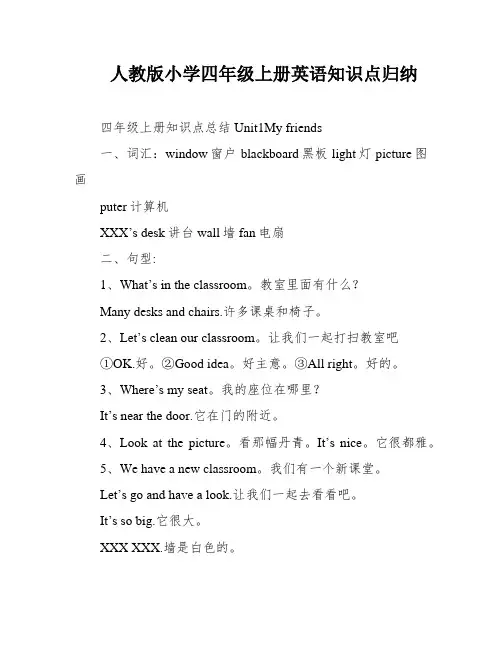
人教版小学四年级上册英语知识点归纳四年级上册知识点总结Unit1My friends一、词汇:window窗户blackboard黑板light灯picture图画puter计算机XXX’s desk讲台wall墙fan电扇二、句型:1、What’s in the classroom。
教室里面有什么?Many desks and chairs.许多课桌和椅子。
2、Let’s clean our classroom。
让我们一起打扫教室吧①OK.好。
②Good idea。
好主意。
③All right。
好的。
3、Where’s my seat。
我的座位在哪里?It’s near the door.它在门的附近。
4、Look at the picture。
看那幅丹青。
It’s nice。
它很都雅。
5、We have a new classroom。
我们有一个新课堂。
Let’s go and have a look.让我们一起去看看吧。
It’s so big.它很大。
XXX XXX.墙是白色的。
6、Let me clean the window.让我来擦窗户。
Good job!做得好!3、语法:1.Where指导的非凡疑问句:Where“那里”,看到where 就要想到地址方位词,比方:on,in,under,near,behind等。
2.Let’s = Let us让我们Let me让我疑问词意义用法特殊疑问句例句1.What’s your name?你叫甚么名字?what甚么用来问是甚么,叫甚么2.What’s your father?你爸爸是干甚么的?做什么等3.what is in your box?你的盒子里是什么?4what is XXX?What time什么时间用来问时间1.What time is it?几点了?2.What time is it now?现在几点了?What about怎么样用来征求意见或询问1.what bout this pair of shoes?这双鞋子怎样?感受等,大多用于承接2.what about you?你呢?上面的同样问题3.what about your dad?你爸爸呢?用来问数量1.How many apples do you have?你有多少苹果?2.How many students are there in your class。
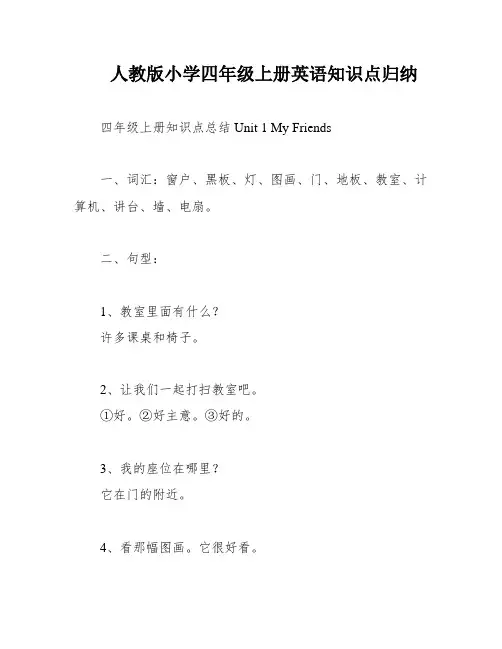
人教版小学四年级上册英语知识点归纳四年级上册知识点总结 Unit 1 My Friends一、词汇:窗户、黑板、灯、图画、门、地板、教室、计算机、讲台、墙、电扇。
二、句型:1、教室里面有什么?许多课桌和椅子。
2、让我们一起打扫教室吧。
①好。
②好主意。
③好的。
3、我的座位在哪里?它在门的附近。
4、看那幅图画。
它很好看。
5、我们有一个室。
让我们一起去看看吧。
它很大,墙是白色的。
6、让我来擦窗户。
做得好!三、语法:1、Where 引导的特殊疑问句:看到 where 就要想到地点方位词,例如:on。
in。
under。
near。
behind 等。
2、Let’s = Let us 让我们Let me 让我特殊疑问句例句:1、你叫什么名字?2、你爸爸是干什么的?3、你的盒子里是什么?4、北京的天气怎么样?5、现在几点了?6、这双鞋子怎么样?7、你呢?1.I'm XXX.2.How many cups of milk do you need。
Three.3.Excuse me。
where is the nearest bookshop?4.What is your father's job?5.How are you。
- Fine。
thanks.6.How much is it。
Five yuan.Unit 2: My SchoolbagVocabulary: Chinese book。
English book。
maths book。
schoolbag。
storybook。
XXX。
candy。
XXX.XXX:1.How many books do you have。
- I have six。
/ Six.2.I have a new schoolbag。
- What colour is it。
- It's black and white.3.May I have a look。
- Sure。
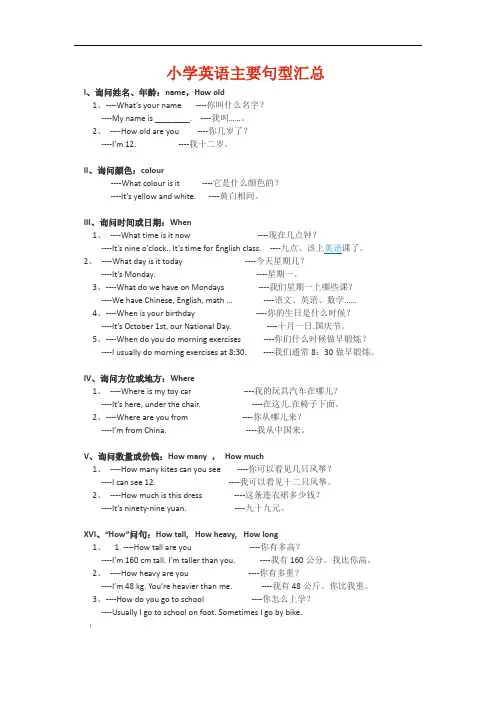
小学英语主要句型汇总I、询问姓名、年龄:name,How old1、----What’s your name----你叫什么名字?----My name is ________. ----我叫……。
2、----How old are you ----你几岁了?----I’m 12.----我十二岁。
II、询问颜色:colour----What colour is it ----它是什么颜色的?----It’s yellow and white.----黄白相间。
III、询问时间或日期:When1、----What time is it now ----现在几点钟?----It’s nine o’clock.. It’s time for English class.----九点。
该上英语课了。
2、----What day is it today ----今天星期几?----It’s Monday.----星期一。
3、----What do we have on Mondays ----我们星期一上哪些课?----We have Chinese, English, math …----语文、英语、数学……4、----When is your birthday ----你的生日是什么时候?----It’s October 1st, our National Day.----十月一日.国庆节。
5、----When do you do morning exercises ----你们什么时候做早锻炼?----I usually do morning exercises at 8:30. ----我们通常8:30做早锻炼。
IV、询问方位或地方:Where1、----Where is my toy car ----我的玩具汽车在哪儿?----It’s here, under the chair.----在这儿.在椅子下面。
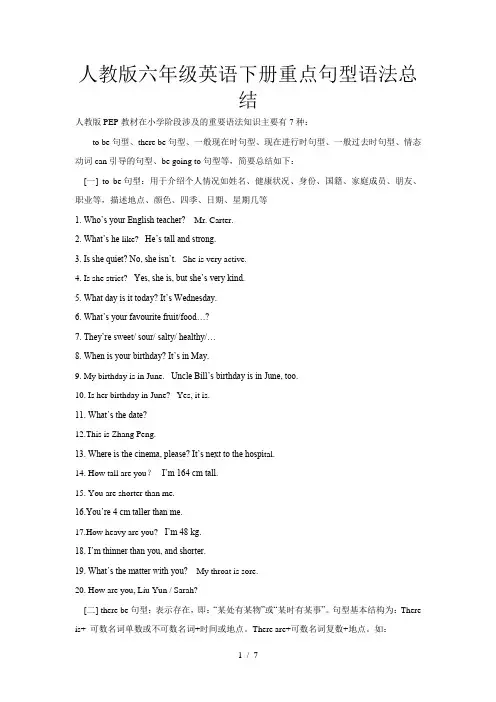
人教版六年级英语下册重点句型语法总结人教版PEP教材在小学阶段涉及的重要语法知识主要有7种:to be句型、there be句型、一般现在时句型、现在进行时句型、一般过去时句型、情态动词can引导的句型、be going to句型等,简要总结如下:[一] to be句型:用于介绍个人情况如姓名、健康状况、身份、国籍、家庭成员、朋友、职业等,描述地点、颜色、四季、日期、星期几等1. Who’s your English teacher?Mr. Carter.2. What’s he like? He’s tall and strong.3. Is she quiet? No, she isn’t.She is very active.4. Is she strict? Yes, she is, but she’s very kind.5. What day is it today? It’s Wednesday.6. What’s your favourite fruit/food…?7. They’re sweet/ sour/ salty/ healthy/…8. When is your birthday? It’s in May.9. My birthday is in June. Uncle Bill’s birthday is in June, too.10. Is her birthday in June? Yes, it is.11. What’s the date?12.This is Zhang Peng.13. Where is the cinema, please? It’s next to the hospi tal.14. How tall are you?I’m 164 cm tall.15. You are shorter than me.16.You’re 4 cm taller than me.17.How heavy are you? I’m 48 kg.18. I’m thinner than you, and shorter.19. What’s the matter with you?My throat is sore.20. How are you, Liu Yun / Sarah?[二] there be句型:表示存在,即:“某处有某物”或“某时有某事”。
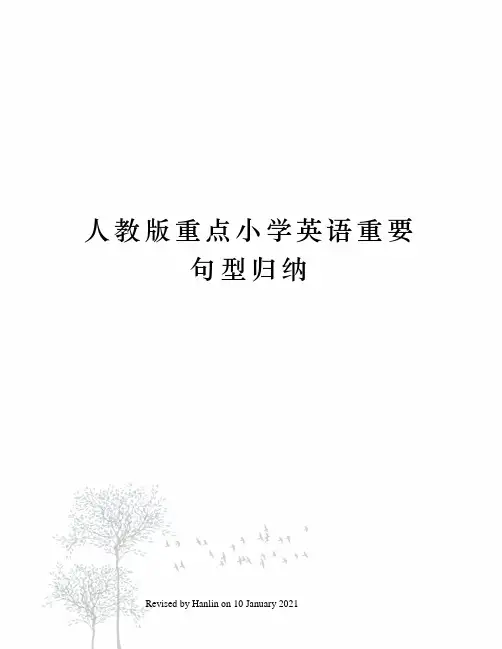
人教版重点小学英语重要句型归纳Revised by Hanlin on 10 January 2021三年级上册1.---What’syourname——你的名字是什么---MynameisChenJie.——我的名字是陈洁。
2.---ThisisJohn,——这是约翰。
---Nicetomeetyou.——见到你很高兴。
3.---Howareyou——你好吗---I’mfine,thankyou.——我很好。
谢谢。
4.---Let’spaint.——让我们一起画画吧。
---Great.——太好了。
5.---Look!Ihavearabbit.——看!我有一只兔子。
---Cool.——真酷!6.---MayIhavealook——我能看一下吗---Sure.Hereyouare.——当然可以,给你。
7.Ilikehamburgers.——我喜欢汉堡包。
8.---HavesomeFrenchfries.——吃一些薯条吧。
---Thankyou.——谢谢。
9.---CanIhavesomechicken——我可以吃一些鸡肉吗---Sure.Hereyouare.——当然可以,给你。
10.---Howoldareyou——你几岁了---I’m9.——我9岁。
11.---Howmanyballoons——有多少只气球---4.——4只。
三年级下册1.---Whereareyoufrom——你来自哪里---I’mfromAmerica.——我来自美国。
2.---Who’sthatwoman——那位女士是谁---She’smymother.——她是我的妈妈。
3.---Who’sthatman——那位男士是谁---He’smyfather.——他是我的爸爸。
4.---Howmanykitescanyousee——你能看见多少只风筝---Icansee12——我能看见12只。
5.---Howmanycrayonsdoyouhave——你有多少支油画棒---Ihave16.——我有16支。
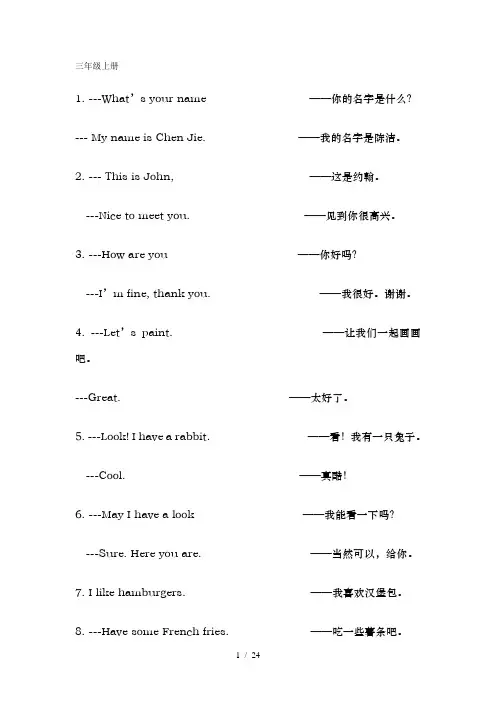
三年级上册1. ---What’s your name ——你的名字是什么?--- My name is Chen Jie. ——我的名字是陈洁。
2. --- This is John, ——这是约翰。
---Nice to meet you. ——见到你很高兴。
3. ---How are you ——你好吗?---I’m fine, thank you. ——我很好。
谢谢。
4. ---Let’s paint. ——让我们一起画画吧。
---Great. ——太好了。
5. ---Look! I have a rabbit. ——看!我有一只兔子。
---Cool. ——真酷!6. ---May I have a look ——我能看一下吗?---Sure. Here you are. ——当然可以,给你。
7. I like hamburgers. ——我喜欢汉堡包。
8. ---Have some French fries. ——吃一些薯条吧。
---Thank you. ——谢谢。
9. ---Can I have some chicken ——我可以吃一些鸡肉吗?--- Sure. Here you are. ——当然可以,给你。
10. ---How old are you ——你几岁了?---I’m 9. ——我9岁。
11. ---How many balloons ——有多少只气球?---4. ——4只。
三年级下册1. ---Where are you from ——你来自哪里?--- I’m from America. ——我来自美国。
2. --- Who’s that woman ——那位女士是谁?---She’s my mother. ——她是我的妈妈。
3. --- Who’s that man ——那位男士是谁?---He’s my father. ——他是我的爸爸。
4. ---How many kites can you see ——你能看见多少只风筝?---I can see 12 ——我能看见12只。
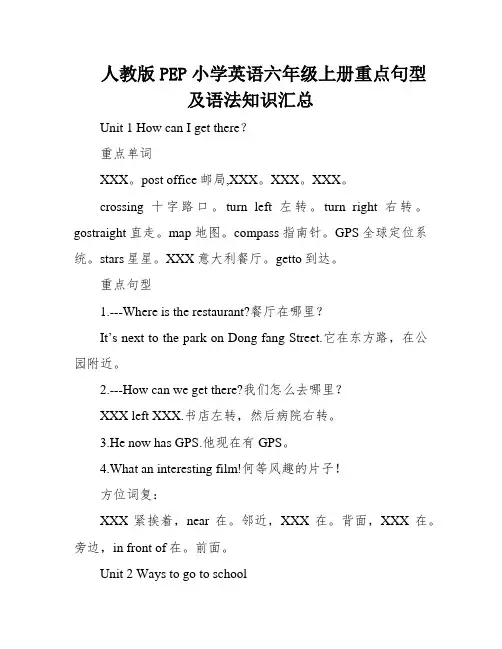
人教版PEP小学英语六年级上册重点句型及语法知识汇总Unit 1 How can I get there?重点单词XXX。
post office邮局,XXX。
XXX。
XXX。
crossing十字路口。
turn left左转。
turn right右转。
gostraight直走。
map地图。
compass指南针。
GPS全球定位系统。
stars星星。
XXX意大利餐厅。
getto到达。
重点句型1.---Where is the restaurant?餐厅在哪里?It’s next to the park on Dong fang Street.它在东方路,在公园附近。
2.---How can we get there?我们怎么去哪里?XXX left XXX.书店左转,然后病院右转。
3.He now has GPS.他现在有GPS。
4.What an interesting film!何等风趣的片子!方位词复:XXX紧挨着,near在。
邻近,XXX在。
背面,XXX在。
旁边,in front of在。
前面。
Unit 2 Ways to go to school重点单词on foot走路。
by bike骑车。
by bus乘公交。
by train乘火车。
XXX乘地铁。
by ship搭船。
by XXX乘飞机。
slow down 慢下来。
XXX交通灯。
traffic rules交通划定规矩。
go/come to school上学。
by sled坐雪橇。
byferry坐轮渡。
pay n to留意。
traffic lights交通灯。
and wait at a red light红灯停等一等。
slow downand。
at a yellow light黄灯减速并停下。
Go XXX。
重点句型1.---How do you come to school?你怎么上学?----Usually。
I come on foot.通常我走路来的。
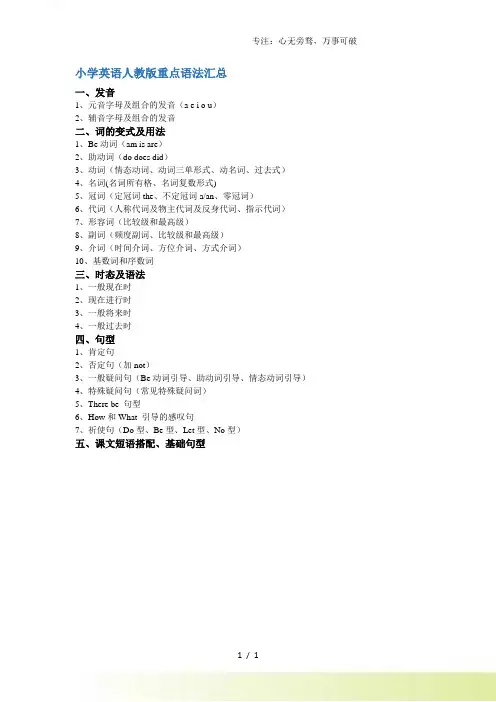
专注:心无旁骛,万事可破
小学英语人教版重点语法汇总
一、发音
1、元音字母及组合的发音(a e i o u)
2、辅音字母及组合的发音
二、词的变式及用法
1、Be动词(am is are)
2、助动词(do does did)
3、动词(情态动词、动词三单形式、动名词、过去式)
4、名词(名词所有格、名词复数形式)
5、冠词(定冠词the、不定冠词a/an、零冠词)
6、代词(人称代词及物主代词及反身代词、指示代词)
7、形容词(比较级和最高级)
8、副词(频度副词、比较级和最高级)
9、介词(时间介词、方位介词、方式介词)
10、基数词和序数词
三、时态及语法
1、一般现在时
2、现在进行时
3、一般将来时
4、一般过去时
四、句型
1、肯定句
2、否定句(加not)
3、一般疑问句(Be动词引导、助动词引导、情态动词引导)
4、特殊疑问句(常见特殊疑问词)
5、There be 句型
6、How和What 引导的感叹句
7、祈使句(Do型、Be型、Let型、No型)
五、课文短语搭配、基础句型
1/ 1。
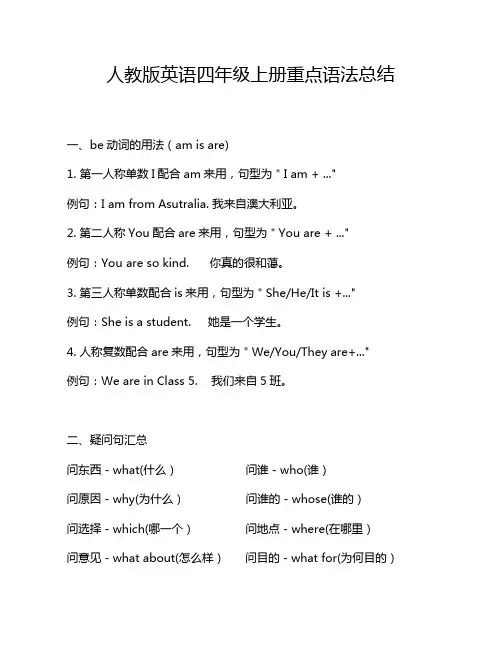
人教版英语四年级上册重点语法总结一、be动词的用法(am is are)1. 第一人称单数I配合am来用,句型为"I am + ..."例句:I am from Asutralia. 我来自澳大利亚。
2.第二人称You配合are来用,句型为"You are + ..."例句:You are so kind. 你真的很和蔼。
3.第三人称单数配合is来用,句型为"She/He/It is +..."例句:She is a student. 她是一个学生。
4.人称复数配合are来用,句型为"We/You/They are+..."例句:We are in Class 5. 我们来自5班。
二、疑问句汇总问东西-what(什么)问谁-who(谁)问原因-why(为什么)问谁的-whose(谁的)问选择-which(哪一个)问地点-where(在哪里)问意见-what about(怎么样)问目的-what for(为何目的)问情况-how(怎么样)问颜色-what color(什么颜色)问年龄-how old(多大)问时间-when(什么时候)问数量-how many(多少)问时间-what time(什么时间)问价钱-how much(多少钱)问具体日期-what date(什么日期)问路程-how far(多远)问星期-what day(星期几)三、五大基本句型1. 第一种句型:主谓SV主语+谓语动词I know.(我知道)2.第二种句型:主谓宾SVO主语+谓语+宾语She helped me. (她帮助了我)3.第三种句型:主谓宾宾SVOO主语+谓语+间接宾语 +直接宾语He gave me a book. (他给了我一本书)4.第四种句型:主谓宾宾补SVOC主语+谓语 + 宾语 +宾语补足语The story made you happy(这个故事让你开心)5.第五种句型:主系表SVC主语+系动词+表语She is kind(他很和蔼)四、小学英语常见的缩写形式1. 代词与系动词的缩写I'm=I am he's=he is it's = it is that's= that isyou're = you are we're=we are they're = they are 2.系动词、助动词与副词的缩写isn't = is not can't = can not haven't = have not don't = do not doesn't = does not won't = will not 3.疑问词与系动词的缩写who's = who is how's = how is when's = when is what's = what is where's = where is4.代词与助动词的缩写I'd = I would we'll = we will we've = we have五、人称代词,主代词,反身代词汇总注意:第三人称主格she he it的复数形式都是 they第三人称宾格 her him it的复数形式都是 them六、反身代词的用法:可作同位语,宾语,表语例句1: The little boy goes to school himself.(这个小男孩自己去上学。
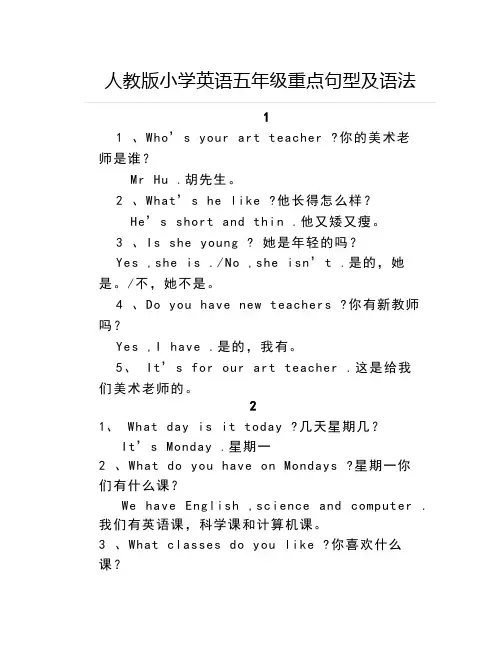
人教版小学英语五年级重点句型及语法11 、Who’s your art teacher ?你的美术老师是谁?Mr Hu .胡先生。
2 、What’s he like ?他长得怎么样?He’s short and thin .他又矮又瘦。
3 、Is she young ? 她是年轻的吗?Yes ,she is ./No ,she isn’t .是的,她是。
/不,她不是。
4 、Do you have new teachers ?你有新教师吗?Yes ,I have .是的,我有。
5、 It’s for our art teacher .这是给我们美术老师的。
21、 What day is it today ?几天星期几?It’s Monday .星期一2 、What do you have on Mondays ?星期一你们有什么课?We have English ,science and computer .我们有英语课,科学课和计算机课。
3 、What classes do you like ?你喜欢什么课?I like P.E. ,math and Chinese .我喜欢体育课,数学课和语文课。
4 、What day do you like ?你喜欢哪一天?I like Tuesdays .我喜欢星期二。
5 、What do you do on Saturdays ?在星期六你做什么?I often do my homework .我通常做我的家庭作业。
6、 I can play with you .我能和你一起玩。
7 、What about you ?你呢?31、 What would you like for lunch ?午餐想要吃什么?I’d like some tomatoes and mutton .我想要吃一些西红柿和羊肉。
2、What do you have for lunch today ?今天的午餐你吃什么?I have eggplant and tomatoes .我吃茄子和西红柿。
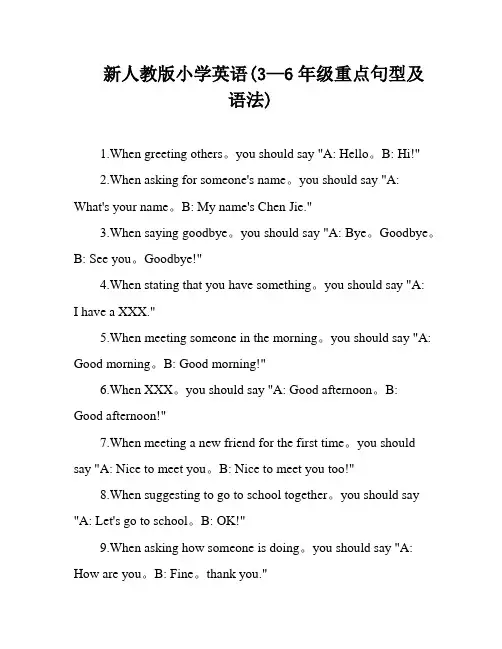
新人教版小学英语(3—6年级重点句型及语法)1.When greeting others。
you should say "A: Hello。
B: Hi!"2.When asking for someone's name。
you should say "A:What's your name。
B: My name's Chen Jie."3.When saying goodbye。
you should say "A: Bye。
Goodbye。
B: See you。
Goodbye!"4.When stating that you have something。
you should say "A:I have a XXX."5.When meeting someone in the morning。
you should say "A: Good morning。
B: Good morning!"6.When XXX。
you should say "A: Good afternoon。
B:Good afternoon!"7.When meeting a new friend for the first time。
you should say "A: Nice to meet you。
B: Nice to meet you too!"8.When suggesting to go to school together。
you should say "A: Let's go to school。
B: OK!"9.When asking how someone is doing。
you should say "A: How are you。
四年级下册英语复习资料重点句型及语法人教版第一单位:Our school一、对应词my ---yourI ---you our---your this --- that here ----thereyes----no come----go teacher----student boy----girl his---her二、知识点1、表示在几楼上,要用介词on,如on the first floor.在一楼。
The first表示第一的,序数词在使用时火线一定要加the,表示事物的排列顺序。
2、先容离自己近的事物时用this is …., 先容离自己比较远的事物时用that is…如:This is my computer. 这是我的谋略机。
That is your computer.那是你的谋略机。
3、how many…?几多?用来询问物品的数量有几多,后面只能跟名词的复数形式。
如How many books do you have?你有几多本书?4、当表示有一个时,名词的火线可以用a或者an.元音前用an , 子音前用a.如an apple一个苹果an orange一个橙子 a pear 一个梨 a dog一只狗5、当用Is this…? Is that…?提问时,一般用肯定回答是:Yes, it is .否定是: No , it isn’t.三、句子:1、This is the teacher’s office.这是老师办公室。
2、That is my classroom.那是我的课堂。
3、Go to the library. Read a story-book..去图书馆。
读故事书。
4、Is this the library? Yes, it is.这是图书馆吗?是的。
5、Is that the art room? No, it isn’t. the art room is on the second floor.(on the third; on the 4th; on the 5th…….)那是美术室吗?不是,美术室在二楼。
小学六年级英语(上册)知识归纳|人教版Unit1How do you go to school?一、重点短语:by plane坐飞机by ship坐轮船on foot步行by bike骑自行车by bus坐公共汽车by train坐火车trafficlights交通灯traffic rules交通规则go to school去上学get to到达get on上车get off下车Stop at a red light.红灯停Wait at ayellow light.黄灯等Go at a green light.绿灯行二、重点句型:1.How do you go to school?你怎么去上学?ually I go to school on foot.SometimesI go by bus.通常我步行去上学。
有时候骑自行车去。
3.How can I get to Zhongshan Park?我怎么到达中山公园?4.You can go by the No.15bus.你可以坐15路公共汽车去。
三、重点语法:1、There are many waysto go somewhere.到一个地方去有许多方法。
这里的ways一定要用复数。
因为there are是There be句型的复数形式。
2、on foot步行乘坐其他交通工具大都可以用介词by…,但是步行只能用介词on。
4、go to school的前面绝对不能加the,这里是固定搭配。
5、USA和US都是美国的意思。
另外America也是美国的意思。
6、go to the park前面一定要加the.如果要去的地方有具体的名字,就不能再加the,如果要去的地方没有具体名字,都要在前面加the.(go to school除外。
)7、How do you go to…?你怎样到达某个地方?如果要问的是第三人称单数,则要用:How does he/she…go to…?8、反义词:get on(上车)---get off(下车)near(近的)—far(远的)fast(快的)—slow(慢的)because(因为)—why(为什么)same(相同的)—different(不同的)9、近义词:see you---goodbye sure---certainly---ofcourse10、频度副词:always总是,一直usually通常often经常sometimes有时候never从来不Unit2Where is the science museum?一、重点短语:library图书馆post office邮局hospital医院cinema电影院bookstore书店science museum科学博物馆turnleft向左转turn right向右转go straight直行north北south南east东west西next to靠近、与……。
人教版五年级英语语法
以下是五年级英语语法的部分总结:
一、一般现在时
一般现在时表示经常或习惯性的动作,也可表示现在的状态或主语具备的性格和能力。
基本结构:主语+谓语+其他(表状态)
二、现在进行时
现在进行时表示此时此刻正在进行的动作或目前阶段正在进行的动作。
基本结构:主语+be动词+动词ing+其他
三、一般过去时
一般过去时表示过去某个时间里发生的动作或存在的状态。
常和表示过去的时间状语连用。
基本结构:主语+谓语+其他(表过去状态)
四、一般将来时
一般将来时表示将来某个时间里将要发生的动作或存在的状态,也表示将来经常或反复发生的动作。
常和表示将来的时间状语连用。
基本结构:主语+will/be going to+动词原形+其他
以上是五年级英语语法中的部分内容,更多内容建议查阅五年级英语课本或咨询英语老师。
人教版重点小学英语重要句型归纳Revised final draft November 26, 2020三年级上册1.---What’syourname——你的名字是什么---MynameisChenJie.——我的名字是陈洁。
2.---ThisisJohn,——这是约翰。
---Nicetomeetyou.——见到你很高兴。
3.---Howareyou——你好吗---I’mfine,thankyou.——我很好。
谢谢。
4.---Let’spaint.——让我们一起画画吧。
---Great.——太好了。
5.---Look!Ihavearabbit.——看!我有一只兔子。
---Cool.——真酷!6.---MayIhavealook——我能看一下吗---Sure.Hereyouare.——当然可以,给你。
7.Ilikehamburgers.——我喜欢汉堡包。
8.---HavesomeFrenchfries.——吃一些薯条吧。
---Thankyou.——谢谢。
9.---CanIhavesomechicken——我可以吃一些鸡肉吗---Sure.Hereyouare.——当然可以,给你。
10.---Howoldareyou——你几岁了---I’m9.——我9岁。
11.---Howmanyballoons——有多少只气球---4.——4只。
三年级下册1.---Whereareyoufrom——你来自哪里---I’mfromAmerica.——我来自美国。
2.---Who’sthatwoman——那位女士是谁---She’smymother.——她是我的妈妈。
3.---Who’sthatman——那位男士是谁---He’smyfather.——他是我的爸爸。
4.---Howmanykitescanyousee——你能看见多少只风筝---Icansee12——我能看见12只。
5.---Howmanycrayonsdoyouhave——你有多少支油画棒---Ihave16.——我有16支。
1.-- Hello. 你好。
--Hi.你好。
2.-What’s your name 你叫什么名字?-My name’. John.我叫约翰。
4、3.-Goodbye! 再见!5、-Bye, Miss White.再见。
6、-Good morning.早上好。
7、Good afternoon.下午好。
6. Nice to meet you.见到你很高兴。
-Nice to meet you, too.见到你也很高兴。
8、7.、--How are you你好吗?9、--I’m fine, thank you.我很好, 谢谢你。
10、Very well, thanks.很好, 谢谢。
--What’s this这是什么?/ What’s that那是什么?-- It’s a duck.(它)是只鸭子。
9 --I’ d like some juice, please.请给我些果汁。
Can I have some water, please请给我些水好吗?--Here you are.给你。
10. You’re welcome.不用谢、Happy birthday!生日快乐!12--How old are you你几岁(了)?-- I’m six years old.我六岁(了)。
1.--Where are you from?你是哪里人?-- I’m from the UK.我是英国人。
2.--Who’s that man 那位男士是谁?--He’s my father. 他是我爸爸。
3.--Who’s that woman 那位女士是谁?--She’s my mother. 她是我妈妈。
4.--Is she your mother 她是你的妈妈吗?--Yes, she is. 是的, 她是。
5.--Is he your father 他是你的爸爸吗?--No.he isn’t.不,他不是。
6、--Where is my pencil box 我的铅笔盒在哪里?--It’s in your desk.在你桌子里。
小学英语语法点复习归纳一、名词复数规则1.一般状况下,直接加-s,如:book-books, bag-bags, cat-cats, bed-beds 2.以s、x、sh、ch结尾,加-es,如:bus-buses, box-boxes, brush-brushes, watch-watches3.以“辅音字母+y”结尾,变y为i, 再加-es,如:family-families, strawberry-strawberries4.以“f或fe”结尾,变f或fe为v, 再加-es,如:knife-knives5.不规则名词复数:man- , woman- , policeman-policewoman- , mouse- child-foot- ,.tooth- fish- , people- ,Chinese- , Japanese-I _________him _________this ___________her ______watch _______that _______photo ________diary ______day________ foot________ book_______ dress ________tooth_______ sheep ______box_______ strawberry _____thief _______yo-yo ______ peach______ sandwich ______tomato______ potato_______ paper_______ juice___________water________ milk________ rice__________ tea__________pork mutton二、一般目前时1.重点:(句子特性;以及第三人称动词旳变化原则)2. 句子出现旳时间标志为:often, usually, everyday,…等词汇)3. 动词变化规则:1).一般状况下,直接加-s,如:cook-cooks, milk-milks,climbs,cleans 2).以s. x. sh. ch. o结尾,加-es,如:guess-guesses, wash-washes, watch-watches, go-goes3).以“辅音字母+y”结尾,变y为i, 再加-es,如:study-studies专题练习:一.写出一下东西旳第三人称单数形式:drink ________ go _______ stay ________ make ________look _________ have_______ pass_______ carry ____come________ watch______ plant_______ fly ________study_______ brush________ do_________ teach_______二.用所给单词旳对旳形式填空1. He often ________(have) dinner at home.2. Daniel and Tommy _______(be) in Class One.3. We _______(not watch) TV on Monday.4. Nick _______(not go) to the zoo on Sunday.5. ______ they ________(like) the World Cup?6. What _______they often _______(do) on Saturdays?7. _______ your parents _______(read) newspapers every day?8. The girl _______(teach) us English on Sundays.9. She and I ________(take) a walk together every evening.10. There ________(be) some water in the bottle.11. Mike _______(like) cooking.12. They _______(have) the same hobby.13. My aunt _______(look) after her baby carefully.14. You always _______(do) your homework well.15. I _______(be) ill. I’m staying in bed.16. She _______(go) to school from Monday to Friday.17. Liu Tao _______(do) not like PE.18. The child often _______(watch) TV in the evening.19. Su Hai and Su Yang _______(have) eight lessons this term.20. What day _______(be) it today?三、目前进行时1.概念:表达正在进行旳动作。
人教版小学英语重点句型语法总结TTA standardization office【TTA 5AB- TTAK 08- TTA 2C】人教版PEP教材在小学阶段涉及的重要语法知识主要有7种:to be句型、there be句型、一般现在时句型、现在进行时句型、一般过去时句型、情态动词can引导的型、be going to句型等。
[一] to be句型:用于介绍个人情况如姓名、健康状况、身份、国籍、家庭成员、朋友、职业等,描述地点、颜色、四季、日期、星期几等,该句型广泛分布于各册教材中,其中5—8册的句型主要有:1. Who’s your English teacher Mr. Carter.2. What’s he like He’s tall and strong.3. Is she quiet No, she isn’t. She is very active.4. Is she strict Yes, she is, but she’s very kind.5. What day is it today It’s Wednesday.6. What’s your favourite fruit/food…7. They’re sweet/ sour/ salty/ healthy/…8. When is your birthday It’s in May.9. My birthday is in June. Uncle Bill’s birthday is in June, too.10. Is her birthday in June Yes, it is.11. What’s the dateis Zhang Peng.13. Where is the cinema, please It’s next to the hospital.14. How tall are you I’m 164 cm tall.15. You are shorter than me.’re 4 cm taller than me.heavy are you I’m 48 kg.18. I’m thinner than you, and shorter.19. What’s the matter with you My throat is sore.20. How are you, Liu Yun / Sarah[二] there be句型:表示存在,即:“某处有某物”或“某时有某事”。
句型基本结构为:There is+ 可数名词单数或不可数名词+时间或地点。
There are+可数名词复数+地点。
该句型主要分布在第5册的Unit 5和Unit 6中,如:1. There are two bedrooms, a kitchen, a bathroom and a living room.2. There is a mirror, a bed and a big closet.3. Is there a forest in the park Yes, there is.4. Is there a river No, there isn’t.5. Are there any pandas in the mountains No, there aren’t.6. Are there any fish in the rivers Yes, there are.[三] 一般现在时句型:表示习惯性的动作或行为,或现在存在着的状况。
句型基本结构为:主语+行为动词+其他。
当主语是第三人称单数时,要在动词原形后面加s 或es,其他人称作主语时则用动词原形,在问句及否定句中需要用助动词do或does。
这种句型通常有一些标志词,如:usually often sometimes never always等。
该句型主要分布在第5册Unit2&3,第6册Unit1&2, 第7册Unit4,5,6, 第8册Unit2中。
如:Book5:1. What do you have on Thursdays We have English, math and science on Thursdays.2. What do you do on Saturdays I watch TV on Saturdays.3. I do my homework.4. What do you have for lunch on Mondays We have tomatoes, tofu and fish.5. I l ike fruit. But I don’t like grapes.Book6:1. When do you eat dinner I eat dinner at 7:00 in the evening.2. When do you get up I usually get up at 12:00 noon.3. What do you do on the weekend Usually I watch TV and go shopping.4. Sometimes I visit my grandparents. I often play football. Sometimes I go hiking.5. Which season do you like best I like winter best.6. Why do you like summer/winter?Book7:1. How do you go to school, Sarah2. Usually I go to school on foot. Sometimes I go by bike.3. I like collecting stamps. He likes collecting stamps, too.4. Does she teach math Yes, she does.5. Does she teach English No, she doesn’t. She teaches math.6. What does your mother do What does your father do7. Where does she work She works in a car company.8. How does she go to work She goes to work by bus.9. Where does the rain come from It comes from the clouds.10. Where does the cloud come from It comes from the vapour.11. Where does the vapour come from It comes from the water in the river.12. The sun shines and the water becomes vapour.13. How do you do thatBook8:1. My nose hurts.2. How do you feel I feel sick. How does Amy feel3. You look so happy. You look sad today.[四] 现在进行时句型:表示说话时正在进行的动作或事件,或在短期内正在进行的动作或存在的情况。
标志词是:now 也常用在Look! Listen!等后面。
句型主要结构为:be动词(am, is, are)+动词现在分词(v. ing)。
该句型主要分布在第6册Unit4, 5, 6中。
如:1. What are you doing I’m doing the dishes. I’m reading a book.2. Grandpa is writing a letter. Brother is doing homework. Mom is cooking dinner in the kitchen.3. He is writing an e-mail in the study.3. What is it doing It’s eating bananas.4. What is she doing She’s jumping.5. What are they doing They’re swimming. They’ re climbing trees.6. Are you eating lunch No, we aren’t.7. Are they eating the honey Yes, they are.8. Is he playing chess Yes, he is.9. Is she counting insects No, she isn’t.[五] 一般过去时句型:表示过去发生的而现在已经结束的事件、动作或情况。
句型基本结构为:主语+动词过去式+其他。
标志词通常是:yesterday, last week , last year 等,在问句与否定句中要用助动词did。
该句型分布在第8册Unit3&4中。
如:did you do last weekend I played football.2. Did you help them clean their room Yes, I did.did you do yesterday I went fishing.4. Did you read book Yes, I did.5. Did you clean your room No, I didn’t.did you go on your holiday I went to Xinjiang.7. What did you do there I sang and danced with my new friends.8. How did you go there I went by train.此外,一般过去时也可用来表示客气的询问。
如:Book3 Unit5, Book 5 Unit3中的:What would you like for lunch I’d like some…[六] 情态动词can引导的句型:表示有能力做某事,can后面的动词要用原形。
该句型主要分布在第5册Unit4和第7册Unit1中。
如:Book4: 1. What can you do I can sweep the floor. I can cook the meals.2. I can water the flowers.3. Can you make the bed No, I can’t.4. Can you use a computer Yes, I can.Book7: How can I get to Zhongshan Park You can go by the No. 15 bus.[七] 将来时:我们的教材中出现过两种表示将来时的句型,即:will和be going to句型,主要以be going to句型为主,表示将要做某事或打算做某事。